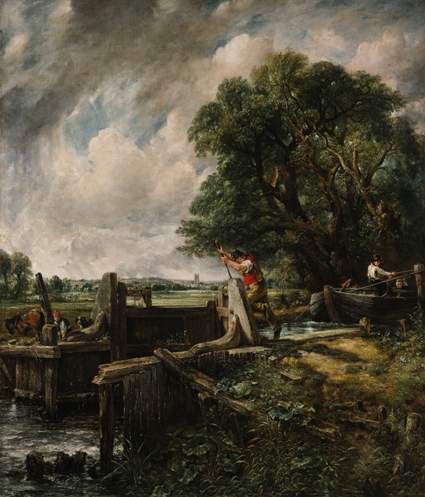
“The Lock” by John Constable (1776–1837), circa 1824–25, oil on canvas, 55 by 48 inches, sold for $13,699,025.
LONDON — “The Lock,” one of John Constable’s most famous compositions sold for $13,699,025 at a Sotheby’s sale on December 9. It has been 160 years since it last appeared on the market. The monumental landscape depicting the countryside of the painter’s “careless boyhood” was the highlight of the Old Master and British paintings evening sale, which featured a significant number of museum-quality artworks.
Painted circa 1824-5 when Constable was at the height of his powers, “The Lock” is one of only three major works by Constable left in private hands. This iconic image is the fifth in the series of six monumental landscapes popularly known as the artist’s “Six-Footers,” which for many define the pinnacle of Constable’s career. Depicting a bucolic scene on the River Stour in the artist’s native Suffolk, and painted in response to the huge critical acclaim that greeted Constable’s first treatment of the composition (exhibited at the Royal Academy in 1824), the picture was treasured by the artist. Retained by him in his studio until the end of his life, singled out by him for prestigious exhibitions, it was chosen as the basis for the engraving that was to make it among the most familiar and celebrated images in the canon of British art.
Following Constable’s death in 1837, the picture was offered, alongside other major masterpieces, in a sale of works from the artist’s studio. It sold to Charles Birch, a leading collector of the day, for £131 and ten shillings — the second highest price in the sale, eclipsing other celebrated works such as Salisbury Cathedral (National Gallery, London).
Some years later, Birch fell on hard times, and in 1855 the painting was offered for sale at auction, alongside other great works from his collection. It sold for £860 — a record price for any work by Constable that remained unchallenged until “The Hay Wain” was sold in 1866. The painting was bought by William Orme Foster, part of a family of highly successful Worcestershire industrialists, in whose family it has remained ever since.
Foster owned one of the leading iron foundries of the early industrial revolution — The John Bradley & Co. Ironworks in Stourbridge. In 1828, one of the company’s subsidiaries manufactured “The Stourbridge Lion,” the first steam locomotive to run on a railway in the United States.
In 1867, Foster bought Apley Hall, a magnificent secluded mansion on the banks of the river Severn in Shropshire. For the next 100 years, “The Lock” hung in the smoking room there alongside many other great works Foster had acquired. Sitting in exquisite parkland, the neo-gothic house was reputedly considered as a potential country residence by Queen Victoria before she settled on Sandringham in Norfolk. It is also believed to be the inspiration for PG Wodehouse’s Blanding’s and the setting for some of Jeeves and Wooster’s most celebrated escapades.

